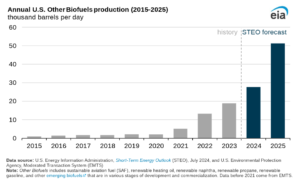U.S. fuel ethanol production expanded by 9%, reaching a record high 1.196 million barrels per day the week ending Jan. 9. The week ending Jan. 9 marks the fourth time…
Domestic SAF Production Capacity Could Increase by 1400% in 2024
Reuters reported Wednesday that “production capacity of sustainable aviation fuel in the United States could jump by 1400% in 2024 if all announced capacity additions come on line, the U.S. Energy Information Administration said on Wednesday.”
“The EIA anticipates domestic production of (other) biofuels will increase by about 50% in 2024, led by rising SAF production,” Reuters reported. “…The EIA projects that SAF output will rise from 2,000 (barrels per day) to nearly 30,000 bpd in 2024.”
Other biofuels, according to the EIA, includes sustainable aviation fuel (SAF), renewable heating oil, renewable naphtha, renewable propane, renewable gasoline, and other emerging biofuels that are in various stages of development and commercialization.

2024 Production Capacity Additions
Reuters reported that “Phillips 66’s Rodeo facility in California reached its renewable fuel production target of 50,000 bpd in June, of which 10,000 bpd is SAF. Valero’s Diamond Green project, in partnership with Darling Ingredients, at its Port Arthur, Texas refinery is expected to come online in the fourth quarter of this year and produce 15,000 bpd of SAF by the end of 2024.”
“Investments in SAF have increased due to the U.S. Environmental Protection Agency’s Renewable Fuel Standard (RFS), federal tax credits, and state programs and tax credits incentivizing use of the fuel,” the EIA said in a press release. “The White House also set a goal of meeting 100% of U.S. aviation fuel demand with SAF by 2050. About 1.6 million b/d of petroleum jet fuel was consumed in the United States in 2023, and we project U.S. jet fuel demand in 2050 to exceed 2.0 million b/d in our 2023 Annual Energy Outlook.”
Global Production of SAF and Renewable Fuel Expected Up in 2024, Too
The International Air Transport Association reported at the beginning of June “that its projections for a tripling of Sustainable Aviation Fuels (SAF) production in 2024 to 1.9 billion liters (1.5 million tonnes) are on track. This would account for 0.53% of aviation’s fuel need in 2024.”
“Renewable fuel production is shared by many industries and SAF is a part of renewable fuel production. That is why increasing the production of renewable fuel is key to increasing the potential of SAF,” the IATA said. “Some 140 renewable fuel projects with the capability to produce SAF have been announced to be in production by 2030. If all of these proceed to production as announced, total renewable fuel production capacity could reach 51 million tonnes by 2030, with production capacity spread across almost all regions.”
“In December 2023 IATA reported that some 69 million tonnes of renewable fuel capacity were expected to be available by 2028. The most recent estimate is for 51 million tonnes of renewable fuel capacity to be available in 2030, based on currently announced projects,” IATA reported. “Several factors have resulted in this reduced estimate. Most significant was an evaluation of projects against more stringent criteria for success and for the potential to meet SAF’s exacting sustainability criteria. Additionally, some projects have progressed at a slower pace towards commercial operations. With the right incentives, the potential for international aviation to reach a 5% reduction in carbon emissions by 2030 through SAF remains, provided policies are in place to increase the share of renewable fuel production allocated to SAF.”





